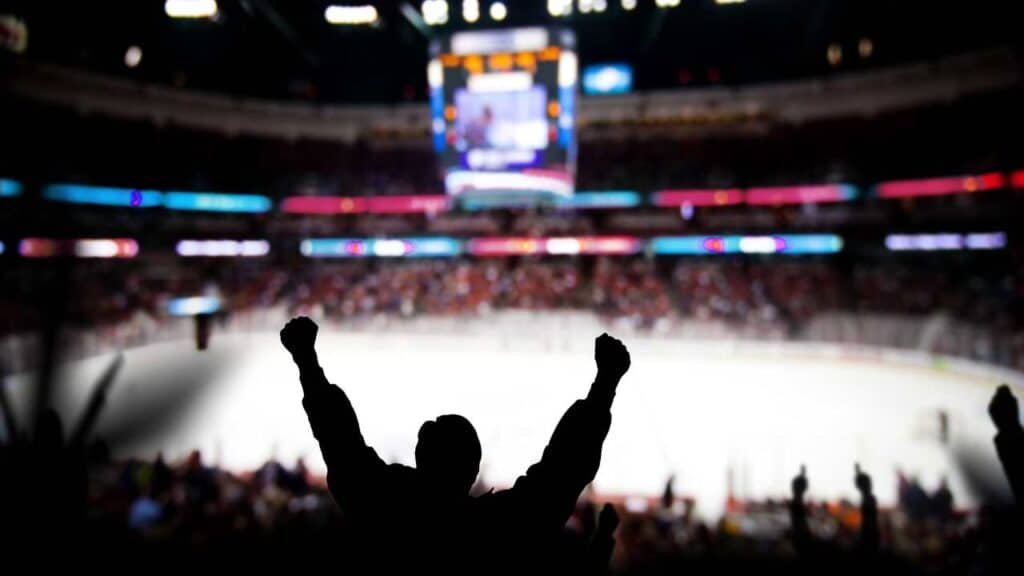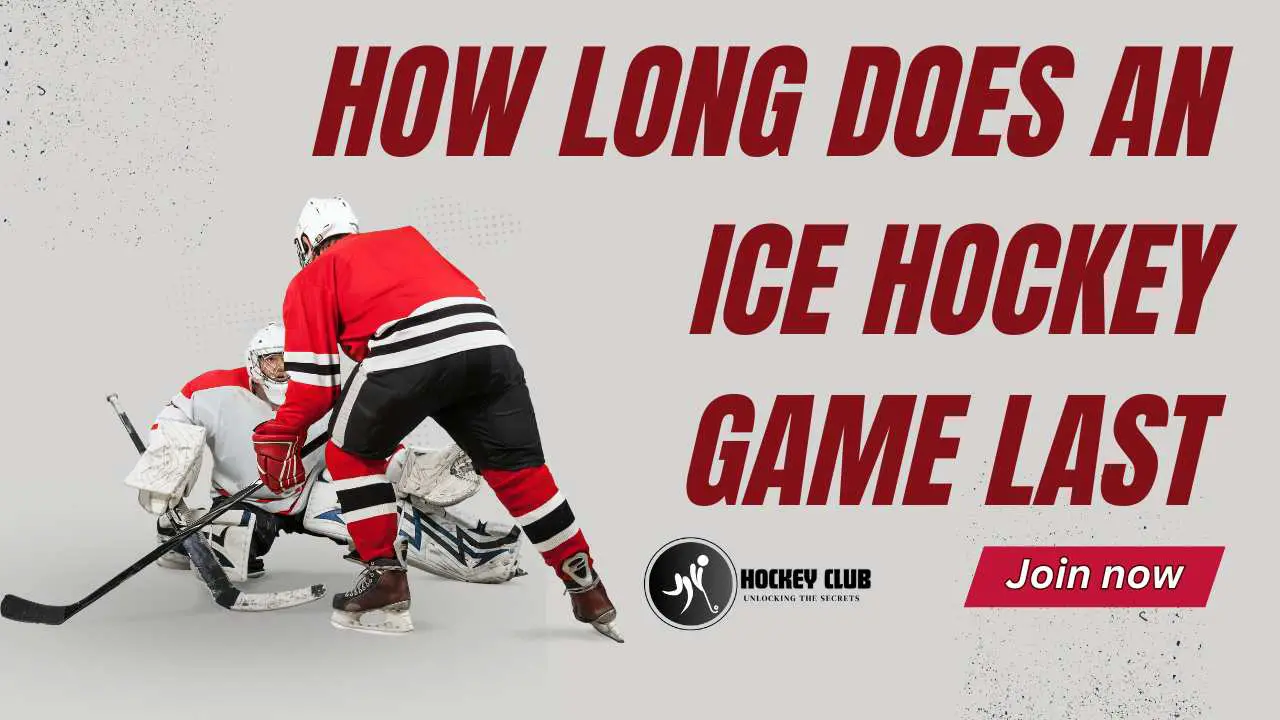Uncover the answer to “How long does an ice hockey game last?” on our website. Find out about regulation time, intermissions, and more.

If you’re wondering just how long an ice hockey game lasts, you’re in the right place! Like many sports, an ice hockey game’s length can vary based on multiple factors, such as overtime, stoppages for penalties, commercial breaks (in professional games), and intermissions. But don’t worry – we’re about to break it all down for you in this comprehensive guide.
Often, the sheer pace of the action, the regular intermissions, and, of course, the thrill of the sport can make an ice hockey game feel like it’s over in the blink of an eye! But in reality, it’s a bit longer than that.
So sit back, relax, and let us guide you through the icy, fast-paced world of ice hockey game durations. Whether you’re a new fan, a player, or simply curious, you’re about to find out exactly what to expect from this exhilarating sporting event. So, ready to dive in? Let’s go!
How long Does An ice hockey game last
An ice hockey game lasts, you’re not alone. This is a common query for both newcomers and experienced fans alike. The duration of a hockey game can hinge on several factors. However, the baseline length of an average ice hockey match pivots on the structure of the game itself. A standard hockey game is divided into three periods, each lasting 20 minutes. Hence, the total time of actual, unbroken play is 60 minutes.
Yet, the amount of time you’ll spend in the stadium or in front of the TV seldom adds up to just one hour. In fact, a typical National Hockey League (NHL) game usually occupies anywhere between two hours and fifteen minutes to three hours. Wondering why is that? Let’s break it down.
The game format includes intervals for rest between periods, which are strategic and necessary for players to rest and recharge. Each intermission lasts approximately 17 minutes, adding a little more than half an hour to the total time.
But that’s not all. Certain situations can drum up the duration of the game. One such instance is penalties. Imposed for rule infractions, penalties can halt the game for a few minutes, extending the original length.
Then there’s overtime and shootouts. If the scores are neck and neck at the end of the third period, the game progresses into a period of ‘sudden death’ over time. In most NHL games, this lasts for a maximum of five minutes. If there’s still no winner following the overtime, the game proceeds to a shootout where players from each team get the opportunity to shoot at the opponent’s goal in turns. This can add another 5-15 minutes.
At times, the games can run significantly longer due to multiple overtimes, especially during playoff games. The longest ice hockey duel recorded in history, which went down between Detroit Red Wings and Montreal Maroons in 1936, lasted a marathon of 176 minutes and 30 seconds and included six overtimes!
So, there you have it! The intuitive yet intricate synergy of standard time, strategic intervals, potential penalties, and possible overtimes, all come together to answer the question of how long an ice hockey game lasts. No matter how it plays out, one thing remains certain – hockey is a game full of surprises and suspense, right till the very last second.
[ez-toc]
How long does an NHL hockey game typically last?
You might be used to watching sports like football or basketball, which are governed by a strict, pre-defined duration of the match. However, when it comes to an ice hockey game, the actual duration can be influenced by a variety of factors.
While a hockey game consists of three 20-minute periods, with actual gameplay time amounting to 60 minutes, this is only the on-ice action. Fun fact, did you know that the three-period standard is believed to provide the optimal pacing for the game and allows strategic interval rests?
Nevertheless, aside from the action on the ice, there are two intermission periods – often around 15 to 18 minutes each, factoring in the Zamboni ice preparation – intervals for TV commercial breaks, as well as waiting time due to penalties and time-outs. Also, don’t forget about the potential for the game to go into overtime and even shootouts in the event of a tie. Each of these elements can add to the overall length of the game.
Moreover, interestingly, NHL playoff games can sometimes extend even beyond this typical length. These games feature multiple 20-minute overtime periods, which continue until a team scores a goal, meaning they can be remarkably longer than regular season games – we’re talking arms-aching, edge-of-your-seat, nail-biting kind of lengthy!
Drawing from historical factors, the longest recorded NHL game took place way back in 1936 between the Detroit Red Wings and the Montreal Maroons. This epic match lasped a jaw-dropping 176 minutes and 30 seconds, which included six overtime periods! ”
In conclusion, although an NHL game is typically scheduled within a certain time slot – often between two hours and 15 minutes to three hours, the actual length can vary greatly depending on various factors. So, the next time you plan to watch a hockey game live or on TV, make sure you have no immediate plans afterward, as the thrill and unpredictability of the game might keep you engaged for longer than you expect!
What is the longest-recorded ice hockey game in history?
- In the 1936 playoffs, a game between the Montreal Maroons and the Detroit Red Wings claimed the record for the longest-ever NHL game. This monumental game ran for a total of 176 minutes and 30 seconds, including six periods of overtime to determine the winner.
- Despite the length of the longest ice hockey game, the clock officially only counts actual playtime. This means pauses, penalties, and intermissions do not get added to the total playing time.
- The Detroit Red Wings eventually won the 1936 game in the sixth overtime period, making it their first win in the Stanley Cup finals.
- The average NHL game, including intermissions and stoppages, lasts between two hours and 15 minutes to three hours, much shorter than the longest recorded game.
- A standard ice hockey game is normally split into three separate 20-minute periods. This format has been established not only to pace the game but also to provide players with strategically timed intervals for rest and strategy adjustments.
- Ice hockey matches are subject to several factors that can affect game length. Overtime, shootouts, and penalties are some of the elements that can extend a game beyond standard duration.
- It’s also noteworthy that the ice has a tight schedule. This means the ice time starts ticking right from the exact match starting time and is precise to the minute.
- The duration of a hockey game can also vary based on the league, the officiating, and specific rules for different tournaments or matches.
Any hockey enthusiast would know that things always get a bit more intense during the playoffs. During these games, the stakes are raised and the format changes slightly. Unlike regular season games, NHL playoffs have the potential to run much longer. Why, you may ask? It’s because they can enter into multiple rounds of sudden death overtime. Instead of heading to a shootout after one overtime period, the teams continue to play 20-minute periods until one of them scores.
This method naturally extends the duration of the game, as it takes time for one of these elite teams to finally break through their opponent’s defense and net the puck. There’s no limitations to these golden goal overtimes as well — there can even be as many as six, like in the longest NHL match mentioned earlier! And forget commercial breaks; during the playoffs, the entertainment is non-stop.
On a different note, don’t forget that penalties also play a role in the game duration! Serious penalties can result in stops and start play that can make games run longer. From tripping and slashing to more severe penalties like game misconducts, these moments contribute to the total running time of a game.
Don’t lose sight of the fact that ice hockey still operates within a pretty tight schedule — after all, there are always more games to be played, often within the same day. Despite all these additional elements that can extend the time, rest assured that your hockey game, on average, should still fall within the 2-3 hours window we mentioned earlier. Just remember, those exceptions can make for some of the most tempestuous and riveting games ever seen!
Do all ice hockey leagues follow the same time rules?
Yes and no. While it’s true that the foundation of ice hockey, its basic structure of three 20-minute periods, remains a constant across most leagues, there can still be variations. These time rules are not strictly identical in every single league around the world. Factors such as the level of play, geographical location, and specific league regulations can result in differences.
For instance, the NHL, arguably the most popular hockey league globally, adheres firmly to the three 20-minute period format. But let’s not overlook that in some situations, if a game is tied at the end of the third period, the NHL employs an additional five minutes of sudden-death overtime. If still tied, a shootout then takes place. Each of these can add significant amounts of time to the game’s duration.
On the other hand, recreational or youth leagues may choose to implement shorter periods, often only 15 minutes long, with shorter breaks as well. The reasons can range from increasing the number of games that can be played in a day, limiting strain on younger players, or simply managing ice time more efficiently.
So, while the essence of mighty hockey remains the same – exhilarating, fast-paced, strategic – the precise duration can be as diverse as the leagues that host the sport. It all adds to the rich tapestry that makes ice hockey such a worldwide phenomenon.
Hockey is a unique sport in the sense that you need each and every guy to help each other and pull in the same direction to be successful.
– Wayne Gretzky
Are there differences in game length between men’s and women’s ice hockey?
Next, let’s discuss the structure of a typical ice hockey match. Normally, it consists of three 20-minute periods. This structure has been found to be the optimal balance for keeping the game’s pace exciting while also providing the players with strategic rest intervals. When you’re watching a game, you’ll notice that it’s clearly divided into these phases, and each one can bring its own twist to the proceedings.
But wait, what happens when the game ends in a tie? This scenario takes us into an exciting territory: overtime and shootouts. In the NHL, for instance, playoff games can exceed the standard length. They undergo multiple 20-minute overtime periods, which only end when a team scores. These tense, sudden-death overtimes can make playoff matches incredibly thrilling, not to mention they can significantly exceed the typical duration.
Ever wondered what the longest hockey game ever was? That record is held by an NHL game in 1936 between the Detroit Red Wings and the Montreal Maroons. The incredible matchup lasted a whopping 176 minutes and 30 seconds! This included an astounding six overtime periods. Just imagine the energy, the suspense, and the sheer physical demands of such a showdown!
Hockey’s strict structure and pacing are key elements that enhance the competitive nature and overall flow of the game. Despite the game’s set structure, the actual length of a hockey match can vary based on numerous factors, such as overtime, penalties, injuries, and even television timeouts. So, next time you watch a match, you’ll have a bit more insight into the intricacies of its duration.
If the game is tied at the end of the three periods, a 5-minute sudden-death overtime is played. During the overtime, teams take turns to get possession of the puck, and the intensity of the game significantly increases, as the first goal scored will end the game there and then. If neither team is able to score during the 5-minute sudden-death overtime, a shootout takes place to determine the winner.
Shootouts add another layer of nerve-racking excitement to the game. Each team selects three players who take turns shooting at the opposing goalie. If the score remains tied after each team’s three shooters have taken their shots, the shootout continues, but with the shooting order reversed. This process continues until a victor emerges, potentially extending the duration of the game.
However, bear in mind that overtime rules can differ between leagues and also between regular season games and playoff games. For instance, in the playoffs, the rules change significantly. Instead of a 5-minute sudden-death period, multiple 20-minute full periods are played until a team scores. This unique factor can extend the length of a playoff hockey game way beyond the typical 60-minute run time of a standard game.
Finally, it’s worth noting that penalties can also affect the length of a hockey game. When a player is penalized, the clock stops, and the player is sent off for a specific length of time, which can vary depending on the severity of the infraction. During these penalty periods, the game continues at a slower pace, slightly extending the length of the game.
So, to sum up, while a standard ice hockey game is meant to last 60 minutes of actual play time, distributed into three 20-minute periods, the real-world duration of the game can be influenced by several factors, including overtime periods, shootouts, and penalties.
Final Thought
So there you have it! An ice hockey game is a fascinating sporting event that can keep you on the edge of your seat, whether you’re a die-hard hockey fan or just a casual observer. It’s a game filled with strategy, skill, and an immense amount of energy. But remember, the actual game length can mean different things.
From the twenty-minute periods, always conceived as the perfect balance for maintaining high-energy gameplay and skill display, to the additional time factors like warmup activities, cool-down exercises, and, of course, the often nail-biting real-time thrillers like Overtimes and Shootouts. Each of these adds distinct minutes to the overall runtime of a match.
Then there’s the role of the referees, these crucial game changers, who besides from making critical decisions also handle game stoppages. They can consult replays on controversial plays, goals, or penalties – all of which can affect the duration of the game.
We should not forget the commercial breaks, either. In professional leagues like the NHL, such breaks are a normal part of the game, yet they also add significant time to the overall match runtime.
Ultimately, you might wonder – why does any of this time factor matter? Simply put, understanding these elements not only enhances your appreciation of the game but also helps you better plan your viewing time, whether you’re catching a match at home, at a local sports bar, or right in the throbbing heart of the stadium.
Let’s answer some of your questions.
What is the official duration of an ice hockey game?
The official duration of an ice hockey game is typically 60 minutes, divided into three 20-minute periods. This is the standard for professional leagues such as the National Hockey League (NHL) in North America.
What factors can extend the duration of an ice hockey game?
Lastly, the pace of the game can also impact its duration. A game that features a lot of stop-and-start play, with frequent whistles and face-offs, will take longer to complete than a game that features more continuous play.
How does the duration of an ice hockey game compare to other sports?
Compared to baseball, ice hockey games are usually shorter. A typical baseball game can last anywhere from 2.5 to 4 hours, depending on the number of innings and the speed of play. Soccer games, on the other hand, are generally shorter than ice hockey games, with a total duration of about 1.5 to 2 hours, including half-time.




